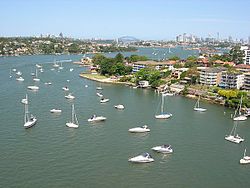
Back Río Parramatta AN نهر باراماتا Arabic نهر باراماتا ARZ Parramatta River CEB Parramatta River German Río Parramatta Spanish Parramatta (fleuve) French Sungai Parramatta ID Parramatta (fiume) Italian Sungai Parramatta Malay
The Parramatta River is an intermediate tide-dominated, drowned valley estuary[2] located in Sydney, New South Wales, Australia. With an average depth of 5.1 metres (17 ft),[3] the Parramatta River is the main tributary of Sydney Harbour, a branch of Port Jackson. Secondary tributaries include the smaller Lane Cove and Duck rivers.
Formed by the confluence of Toongabbie Creek and Darling Mills Creek at North Parramatta,[4] the river flows in an easterly direction to a line between Yurulbin in Birchgrove and Manns Point in Greenwich.[5] Here it flows into Port Jackson, about 21 kilometres (13 mi) from the Tasman Sea. The total catchment area of the river is approximately 252.4 square kilometres (97.5 sq mi) and is tidal to Charles Street Weir in Parramatta, approximately 30 kilometres (19 mi) from the Sydney Heads.[6]
The land adjacent to the Parramatta River was occupied for many thousands of years by Aboriginal peoples of the Wallumettagal nations and the Wangal, Toongagal (or Tugagal), Burramattagal, and Wategora clans of the Darug people. They used the river as an important source of food and a place for trade.[1][7] The river was formed 15 to 29 million years ago as its waters began to cut a valley into sandstone and shale.[8]
- ^ a b "A brief history of our waterways". Parramatta City Council. 12 December 2010. Retrieved 4 September 2012.
- ^ Roy, P. S; Williams, R. J; Jones, A. R; Yassini, I; et al. (2001). "Structure and Function of South-east Australian Estuaries". Estuarine, Coastal and Shelf Science. 53 (3): 351–384. Bibcode:2001ECSS...53..351R. doi:10.1006/ecss.2001.0796.
- ^ Parramatta River by Office of Environment and Heritage NSW
- ^ "The creeks of Sydney's west: Upper Parramatta River". Sydney Travellers' Guide. Stephen Yarrow. 2010. Archived from the original on 4 February 2012. Retrieved 30 August 2012.
- ^ "Parramatta River". Geographical Names Register (GNR) of NSW. Geographical Names Board of New South Wales. Retrieved 2015-05-07.
- ^ "Parramatta River Estuary: Data Compilation and Review Study" (PDF). Parramatta River Estuary Management Committee. July 2008. Retrieved 30 August 2012.
- ^ "Parramatta River Walk" (PDF). Walking Volunteers. September 2011. Retrieved 4 September 2012.
- ^ Hoskins, Ian (2015). "River Cycles - A History of the Parramatta River". Dictionary of Sydney. Dictionary of Sydney Trust. Retrieved 9 Feb 2021.
© MMXXIII Rich X Search. We shall prevail. All rights reserved. Rich X Search

